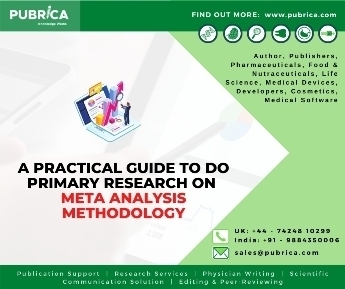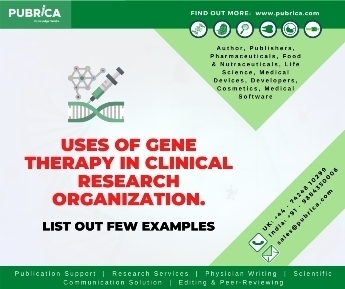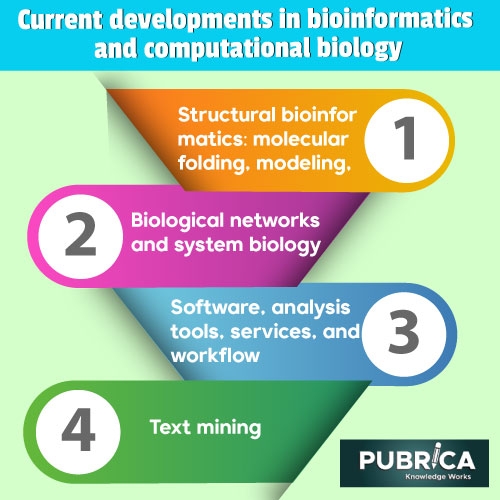
A practical Guide to do Primary research on Meta analysis Methodology
February 26, 2021
Uses of gene therapy in clinical research organization. List out few examples
March 9, 2021In-Brief
- Bioinformatics includes information technology and computers to large molecular biology data sets.
- Bioinformatics is anticipated as a cutting-edge branch of the biotechnology sector, which help in drug innovation and personalized medical treatments.
- The field closely associates artificial intelligence and computer science with microbiology and genomics.
Introduction
Bioinformatics is an interdisciplinary field of life sciences that develops methods and software tools that help understand biological data, particularly when the data sets are large. Its application and research comprise genomics data analysis, genome annotation, molecular folding, gene/protein prediction and molecular sequence. It also includes developing databases and data management systems, software and analysis tools.
Bioinformatics education and training are necessary to understand the basics and specifics of bioinformatics and create new generation specialists and scientists with integrated, interdisciplinary, and multilingual knowledge to use recent bioinformatics sources powered with advanced operating systems, software, and database/networking technologies. A systematic review paper helps create a review that formulates a question that uses systematic and reproducible methods to identify, select and critically appraise all relevant research, and gather and analyze data from the analysis included in the Review.
Systematic review writing
Bioinformatics encourages prospects for novel discoveries and reveals pathways for biological experiments with the support of data analysis. Research in this field mainly depends on high-quality databases to offer precise outcomes. However, most biological databases have obtainable mistakes, such as data wrongly classified or incomplete information. These mistakes may be problematic. Recent data mining algorithms may use the filter data. However, sometimes these algorithms cannot treat these faults, leading to severe problems for analysis. Manual data curation and extracted data from literature is a solution to this problem. For example, a database of mutations effects on protein-ligand affinities, composed of 1,000 mutations, was generated through a deep search in the literature. Nevertheless, the manual analysis may be address bias risk, which may not collect all possible data necessary for a determined study.
Manual curation also permits the identification of mistakes and, when possible, corrects them. Therefore, systematic literature reviews used to collect data for bioinformatics analysis. Systematic Review is a technique used to discover, estimate and summarize the state-of-the-art of a precise theme in the literature. Systematic Review writing helps gather literature information restrictively that allows a rigorous methodological analysis with lower prejudice than the traditional reviews. Conducting a systematic review, the objective is to build a general vision of a specific question and give it a reasonable summary of the literature. To perform systematic reviews is essential to follow a pre-established and well-defined protocol.
Following the distinct systematic steps may guarantee the reproducibility of the study. Some monitors have been proposed to help commentators to construct Systematic Literature Review. Also, estimation approaches of Systematic Literature Review quality, such as the PRISMA declaration, is which PRISMA (Preferred Reporting Items for Systematic Reviews and MetaAnalyses) describes a set of items to help authors advance the reporting of Systematic Literature Review.
Structural bioinformatics: molecular folding, modelling, and design
One of the commonly used applications of bioinformatics is the identification of three-dimensional protein molecular modelling, structure, and folding to forecast the possible function of proteins or model behaviour of molecules, other molecular structures, fold the molecule to its natural biologically functional three-dimensional structure and help in creating biomedical drugs for various complicated human diseases.
It is used in designing the structuring of biological molecules and enzymes. There are few examples where they are widely in use de novo protein design, protein-peptide interaction, protein-ligand/drug docking, enzyme design, macromolecular complexes, and structure prediction of biological macromolecules. It supports the prediction that the structure of a protein depends on the known structure of a homologous protein(s). Apart from that, the discovery of secondary, tertiary, and quaternary structures of proteins is significant to understand proteins’ function. The exact three-dimensional structure is necessary for correct function, and a failure to fold into native construct generally produces inactive proteins or misfolded proteins that can be toxic.

Biological networks and system biology
The properties of network topology are widely applied in many scientific fields, including bioinformatics, leading to the construction of large-scale biological networks represented as “omes” like biome, interactome, microbiome.
The above emphasized molecular sequence analysis, annotation, prediction, and molecular modelling-associated to bioinformatics methods are also the principal for organizing, building, and genetic and biochemical pathways of complex cellular processes. These signal transduction comprise reception, and gene co-expression and gene regulation. Such molecular networks incorporate various data types, including DNA sequences, regulatory RNA, proteins, gene expression data, secondary metabolites, and other small molecules, which may be connected physically and functionally. The structuring and organization of such physically and functionally connected molecular networks of cellular processes can be achieved only by applying the combination of simulative, iterative, and model-oriented bioinformatics approaches.
Software, analysis tools, services, and workflow
The key driving force for the present and future development of bioinformatics software and tools, which help in the progress of genome decoding technologies, consequent required for their analyses, accretion of large volume biological data, as well as the development of computer technologies, visualization, graphics, and networking techniques and molecular modelling.
Moreover, the availability of numerous shared object models, open-source codes, and community-maintained plug-ins helps collect new ideas from the community and perform innovative in silico experiments on current “Big Data.”
These all make way for research groups and bioinformatics corporations to experiment, work, and create a more innovative generation of bioinformatics tools and software that are user-friendly and must perform integrated and extended analysis with better visualization and graphical outputs.
Some of the open-source software packages include UGENE, EMBOSS, GenGIS, GENtle, BioPerl, PathVisio, GenoCAD, GenomeSpace, Biopython, Bioclipse, GeWorkbench, .NET Bio, Apache Taverna, BioJS, Bioconductor, BioJava, and BioRuby.
Text mining
Bioinformatics research and application aim to use computational algorithms and bioinformatics tools to gather, construct, and structure the increasing body of biomedical literature permutes scientists to question, mine, study, and synthesize the particular literature and published articles of their research interest.
Therefore, text mining and biomedical literature play a significant role in the scientific enhancement, inventions, and application and integration of discoveries to society through extracting information (EI) and assessing the relationships of publications.
Biomedical literature text mining uses various “text mining & data mining” tools, visualization and navigation, information retrieval, applying techniques such as data clustering and extraction, and text categorization and summarization.
Conclusion
Systematic literature reviews used to collect data for bioinformatics analysis. It is a technique used to discover, estimate and summarize the state-of-the-art of a precise theme in the literature. Systematic Literature Review permits gathering literature information restrictively that allows a rigorous methodological analysis with lower bias than the traditional reviews. The objective is to build a general vision of a specific question and give it a reasonable summary of the literature. Hence, to perform systematic reviews is essential to follow a pre-established and well-defined protocol.
References
- Zomaya, A. Y. (2005). Parallel computing for bioinformatics and computational biology. Wiley.
- Gentleman, R. C., Carey, V. J., Bates, D. M., Bolstad, B., Dettling, M., Dudoit, S., … & Zhang, J. (2004). Bioconductor: open software development for computational biology and bioinformatics. Genome Biology, 5(10), 1-16.



